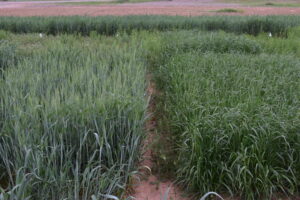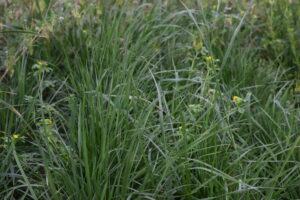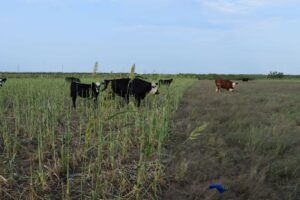Progress report for LS22-373
Project Information
Soil degradation is a 21st century global problem that has been estimated to have decreased soil ecosystem services by 60% between 1950 and 2010 (Lal, 2015; Leon et al., 2014). Lal (2015) noted that once the process of soil degradation is set in motion, often by land misuse and soil mismanagement along with extractive farming, it feeds on itself in an ever-increasing downward spiral. Such processes are particularly severe in rain-limited environments, where rainfall variability exacerbates crop failure and resource degradation (Tittonell et al., 2012). Incorporating livestock into cropping systems can reduce chemical inputs, decrease weed abundance, and enhance nutrient cycling, while maintaining or even increasing crop yields (MacLaren et al. 2019). However, grazing can increase soil compaction, decrease infiltration, and increase the potential of soil erosion depending upon management decisions (Wheeler et al., 2002). Continuous, conventionally tilled, dual-purpose wheat systems are the norm across much of the southern U.S. Great Plains, where wheat is grazed as conditions allow with the option to remove cattle in late winter and subsequently harvest grain. However, this system has led to degraded soil resources and inconsistency from year to year due to variable climatic conditions in this harsh semi-arid environment. Annual wheat systems have been utilized for grazing due to the resilient nature of wheat as well as the lack of a viable alternative. The renewed interest in cover crops has sparked interest in the feasibility of using cover crops as a viable grazing option. Research in the Texas Rolling Plains has shown that warm-season cover crops can provide alternative grazing outside of the typical winter wheat season. In addition, a summer-dormant tall fescue has been developed in the region to provide a viable cool-season perennial. Cover crop mixtures and perennial forage systems have been shown to rapidly increase soil organic matter through liquid carbon pathways, which ultimately improves soil function and improves crop production while decreasing the need for chemical inputs (Jones, 2015). We propose to build upon project LS16-271, which indicated that warm-season cover crop mixes and legume crops can improve soil function in continuous wheat systems compared to summer fallow in semi-arid environments. In addition, this project also found that profit gains were realized through the intensified systems implementing summer crops when fall and/or winter droughts decimated wheat production. In this study, we will evaluate a range of integrated crop-livestock intensity, ranging from annual wheat systems with summer fallow to year-round multi-species mixes to perennial forage-based systems. The assembled team, including cooperating farmers, will quantify impacts of alternative grazing systems on soil function and health, agronomic production, economic viability, and consumer behavior in integrated crop-livestock systems of the southern Great Plains. We hypothesize that systems which provide diversity and armor throughout the year will restore degraded farmlands and provide a more sustainable agricultural strategy.
- Determine the effects of cover crop/forage mixes, crop rotation, and perennial forage-based systems on overall production and soil function.
- Evaluate over-seeding of annual forages in warm-season and cool-season perennial systems to expand sustainable grazing options and soil function.
- Conduct economic analysis of above systems and evaluate social and economic barriers to adoption of alternative integrated crop-livestock systems to restore soil function in semi-arid environments. Document the cost of production and profitability analysis of adopting these integrated systems. Evaluate the adoption barriers highlighting economic and noneconomic considerations.
- Measure ecological services on producer farms that have implemented alternative grazing systems and provide information to stakeholders through educational programs and on-farm tours of evaluated integrated crop-livestock grazing systems.
Cooperators
- - Producer
- - Producer
Research
Objective 1. A replicated research trial was planted at the Smith Ranch near Vernon, TX. There are a total of 20 one-acre plots. Treatments include winter wheat based cropping system with 1) summer fallow; 2) summer cover crop planted at 25 lb/ac; 3) summer cover crop planted at 50 lb/ac; 4) rotation of wheat with cool-season cover/forage crop; and 5) summer dormant tall fescue. The fescue was planted in fall 2020. Each treatment is replicated 4 times. A warm-season mixture containing 16% sorghum-sudangrass, 12% pearl millet, 12% forage sorghum, 36% forage cowpea, 12% mungbean, 4% okra, and 8% sunn hemp was planted using a 20' no-till drill on 7.5 inch spacing at a rate of 25 and 50 lb/ac on June 9, 2022 and July 10, 2023. Plots were clipped to estimate herbage mass before and after grazing. After grazing, plots were rolled with a roller crimper. A cool-season cover crop mixture consisting of triticale (30 lb/ac), winter wheat (20 lb/ac); Austrian winter pea (10 lb/ac); hairy vetch (5 lb/ac); and sweet clover (5 lb/ac) was planted using a 20' no-till drill on 7.5 inch spacing on November 10, 2022. Winter wheat was planted at 60 lb/ac using the same drill on November 11, 2022 and November 7, 2023. Wheat was planted to treatments 1-4 in 2023. Wheat was harvested using a small plot combine on May 21, 2023.
Soil samples were collected October 19, 2022 and to a depth of 48 inches and segmented into increments of 0-4, 4-8, 8-12, 12-24, 24-36, and 36-48 inches. Soil samples from 0-4 and 4-8 inches were sent to the University of Missouri Soil Health Laboratory for microbial analysis via PLFA. Remaining soil samples were collected, processed and stored for soil chemical and physical property analysis. In 2023, soil samples were collected at 0-4 and 4-8 inch increments on November 15, 2023.
Objective 2. Due to the Vernon Research and Extension Center being in the direct path of an EF-3 tornado on May 4, 2022, objective 2 was suspended until 2023. Eight treatments are being evaluated, including: 1) winter wheat (60 lb/ac; annual forage control); 2) summer-dormant tall fescue (; 3) cool-season grass mix consisting of tall fescue, perennial ryegrass, and orchardgrass (Stockmaster); 4) summer-dormant tall fescue + legume (sweetclover, red clover, burr medic, ball clover, and little burr medic); 5) cool-season grass mixture (little barley, Canada wildrye, Indian ricegrass, and tall wheatgrass); 6) legume mixture (sweetclover, red clover, burr medic, ball clover, and little burr medic) ; 7) grass/legume mixture (sweetclover, red clover, burr medic, ball clover, little burr medic, little barley, Canada wildrye, Indian ricegrass, and tall wheatgrass); and 8) annual ryegrass. Plots were planted on October 9, 2023 using a Great Plains no-till cone drill on 7.5-inch row spacing.
Objective 3. A meeting was held with Co-PIs, including economic experts. Inputs will be shared with economic cooperators as research the research has now progressed. We discussed using data from producers to supplement data generated through replicated research. Once the final year begins, a plan will be outlined to complete the objective over the remaining project period.
Objective 4. Twelve one-acre plots were planted on-farm on a portion of land that had been traditionally been planted to winter wheat, although not on a consistent basis. The soil at this location is a loamy sand and generally poor fertility. The producer is interested in creating supplemental grazing opportunities for a cow-calf operation. In June 2022, two warm-season mixes similar to objective 1 were planted, one was sorghum-sudan based for grasses while the other was millet based for grasses. This was due to a concern with prussic acid issues that may be related to sorghum species and grazing. Warm season mix 1 consisted of 10 lb/ac each of sorghum-sudangrass and forage sorghum, and 5 lb/ac each of cowpea (ace), mung bean, and lablab. Warm-season mix consisted of 10 lb/ac each of pearl millet and G. foxtail millet, and 5 lb/ac each of cowpea (ace), mung bean, and lablab. In addition, a legume based mix was also planted consisting of 12 lb/ac cowpea and 5 lb/ac each of sunn hemp, korean lespedeza, mung bean, and 3 lb/ac okra. In fall 2020, summer dormant tall fescue was planted at 15 lb/ac while hairy vetch was planted at 15 lb/ac across all other plots. These same mixes were planted in 2023 with limited success. As a result of extreme summer conditions, the team decided to focus on cool-season forage systems. Cool-season treatments included: 1) grass/legume/brassica mix (barley, oats, rye, triticale, wheat, hairy vetch, winter peas, arrowleaf clover, crimson clover, sweet clover, radish, turnips, rapeseed, alfalfa and berseem clover; 50 lb/ac); 2) annual grass grazing mix (20% each barley, oats, rye, triticale, and wheat; 60 lb/ac)); 3) perennial grass mix (tall wheatgrass (15 lb/ac) and summer-dormant tall fescue (10 lb/ac)); and 4) annual grass mix (wheat, triticale, and annual rygrass (60 lb/ac). Plots were planted on October 10, 2023 using a 20-ft no-till drill on 7.5-inch row spacing.
April 2022- March 2023
After planting the warm-season cover crop mixture, recorded precipitation totaled 1.31 inches in June and 0.09 inches in July. These dry and hot conditions led to poor growth and stressed conditions. Through the first of August, grazing of the cover crop did not appear to be viable due to environmental conditions. However, 3.2 inch rainfall on August 22 with additional small rainfall events led to an emerging crop that was suitable for grazing. In 2022, plots were grazed September 9th-17th. A total of 8 acres with this study in addition to 4.5 acres of another study within a 35-acre field were accessible to 40 cow-calf pairs over the course of the grazing period with access to adjacent rangeland which had a water source. At time of grazing, only the sorghum-sudangrass was evident in the mixture, as all other species succumbed to the harsh conditions. Total herbage mass was 1,170 lb/ac for the 50 lb/ac planting rate and 1,241 lb/ac for the 25 lb/ac seeding rate. Forage parameters such as C:N ratio, crude protein, NDF and ADF were similar between seeding rates. As seen in other studies in this region and previous years at this site location, lowering seeding rates does not significantly compromise herbage mass production. At this site, warm-season annual grassy weeds are also an issue. Planting a summer cover crop provided competition and appeared to eliminate the annual grasses in plots where summer cover crops were planted (See figure 1).
Figure 1. A grazed summer cover crop (left) reduced weed pressure of annual grassy weeds (right).Initial soil results after the first year of this project are provided in the link below. The fall 2022 actually represented the third year of cover crops as the study was initiated in 2020. Plots were also flash grazed in 2020 and 2021. Grazing did not significantly stimulate microbial activity. Water extractable organic carbon trended higher for wheat systems that implemented a summer cover crop or alternated with a cool-season mixture (see link). Surprisingly, the perennial system was similar to the summer fallow treatment. However, this may be due to fair establishment of the fescue with limited growth during the extreme environmental conditions that have been experienced since project initiation. Due to conditions, tall fesuce has not been grazed. Specific fungi and bacteria communities were similar across treatments as well (see link), although levels were trending higher for cover crop and cool-season alternative treatments compared to summer fallow. While grazing did not necessarily stimulate microbial activity or increase soil carbon, these parameters were not negatively impacted by grazing.
April 2023- March 2024
Wheat was harvest in May 2023 with similar yields across all treatments. The summer cover crop mixture was planted later than normal due to drought conditions and awaiting a precipitation event to provide adequate moisture to plant. Initial stands of cover crops were fair, but no precipitation was recorded from July 16th to September 11 with temperatures exceeding 100 oF for much of that time. No measurable cover crop herbage mass was collected in fall 2023. This is the first year out of seven that cover crops did not produce measurable herbage mass for years that cover crops were planted 2013-2023. Soil samples are currently being processed and analyzed.
Objective 2. No field data to report. Plots were well established and preparations are being made to collect herbage mass at the time of reporting. Annual forages, wheat and annual ryegrass, appear to have produced the greatest biomass. However, the perennial grass forages tall fescue and stockmaster (consisting of fescue, perennial ryegrass, and orchardgrass) established well. The native perennial grasses did not appear to establish as well.


Objective 3. Nothing to report. Data analysis and behavioral economic studies will commence in year 3.
Objective 4. Due to extensive drought conditions, no treatment survived in 2022. In addition, conditions did not allow for successful fescue or vetch growth in 2022-2023. Do to failed attempts at this farm, warm-season mixtures will be available to plant earlier in late spring when rainfall may be expected. However, this scenario did not provide desirable results due to exceptional drought conditions. As a results, alternative cool-season forge systems were evaluated beginning in Fall 2023. As seen in objective 2, annual small grain forage systems appear to provide more available forage compared to perennial forage systems during the initial year of establishment. Over time, perennial systems may become more sustainable. Other cooperators with established systems will be contacted in year 2 to begin initial sampling and analysis during year 3.
Education
To date, education has been traditional delivery of project information at stakeholder meetings via oral presentations.
Educational & Outreach Activities
Participation summary:
Project objectives and initial activities have been presented at the 2022 Oklahoma State University Winter Crops School, 2023 Red River Crops Conference, 2023 Concho Valley Cotton Conference, 2023 Baylor/Knox County Soil Health Workshop, 2023 Oklahoma State University Alternative Crops Conference, 2023 Wichita Falls Soil Health Workshop, 2023 9th annual Eccles Family Rural West Conference, 2023 GRAZE - all things livestock conference, and 2024 Texas Seed Trade Association Annual Conference. Research demonstrations are taking place at the Smith Ranch and Streit Farm. A M.S. graduate student presented the data at the 2023 ASA-CSA-SSSA Annual Internation Meeting.
Learning Outcomes
Nothing to report at this time
Project Outcomes
As the project has just begun and some aspects have been delayed due to tornado damage, full analysis of outcomes are not available. However, initial data indicate that cover crops can be planted at lower seeding rates than often recommended to achieve optimum biomass production. We also observed that cover crops can provide direct competition to troublesome annual weeds and reduce such weed pressure. Although harsh environmental conditions were experienced, grazing was completed. The combination of these above provide evidence that lowering cover crop seeding rates while providing supplemental grazing could achieve more sustainable systems in regard to soil health and economic viability. Preliminary data indicate that annual forage systems may provide greater herbage mass production compared to the initial establishment year of annual forage systems.
